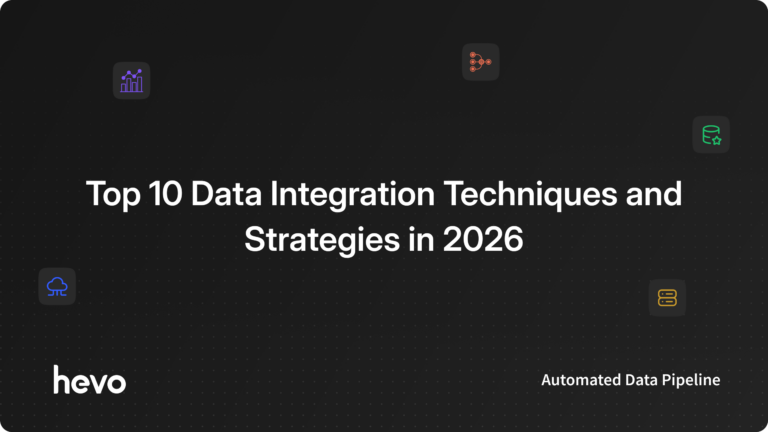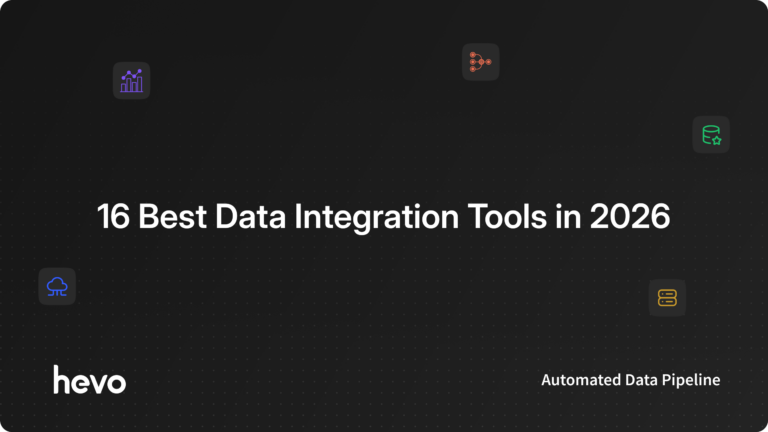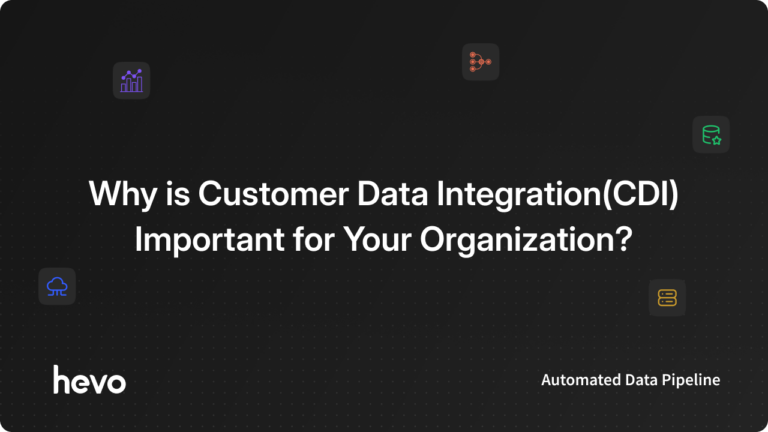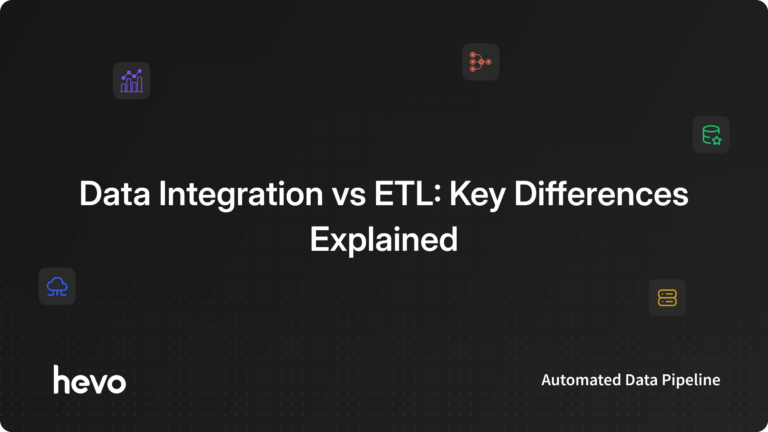Modern data firms need data siloed away at different locations to be in an analysis-ready form in a unified data repository.
This approach of combining data from multiple applications into a single source of truth is called data integration and has become the need of the hour for many businesses. You can supercharge your decision-making progress by applying the right data integration techniques and strategies that cater to your business needs.
But what are these techniques? No need to worry! This article contains a compiled, comprehensive list of data integration techniques, strategies, and types of data integration methods widely used in organizations worldwide.
Table of Contents
Top 10 Data Integration Techniques and Strategies
Based on the disparity, complexity, and number of data sources, you can choose from the following different types of data integration techniques:
1. Data Consolidation

Data consolidation refers to combining data from various sources into a centralized data store that acts as a single source of information for the organization. Organizations often leverage data consolidation tools to streamline this process and ensure accuracy. Enabling you to store data in a unified store, it can be used for all your reporting and analytics use cases and can serve as a data source for other applications.
However, there is some data latency in this data integration method. There will be some time difference between when the data is updated in the original data source and when it gets updated in your central repository.
Since data is transformed before it is consolidated, you get data in a consistent format on the central data source, providing your data professionals an opportunity to improve data quality and integrity.
Trusted by 2000+ customers across 40+ countries, Hevo elevates your data migration game with its no-code platform. Ensure seamless data migration using features like:
- Seamless integration with your desired data warehouse.
- Transform and map data easily with drag-and-drop features.
- Performing pre/post load transformations using drag-and-drop features.
Still not sure? See how Postman, the world’s leading API platform, used Hevo to save 30-40 hours of developer efforts monthly and found a one-stop solution for all its data integration needs.
Get Started with Hevo for Free2. Data Federation

Unlike the data consolidation strategy, where you move all data to a single source of truth, data federation offers a virtual database.
Simplifying access for consuming users and front-end applications, this technique performs data abstraction to create a uniform user interface for easy data access and retrieval.
Your queries to the federated virtual database are sent to the relevant data source, which then returns the data you requested. This is an on-demand data solution compared to other real-time integration techniques.
3. Data Propagation
Data propagation uses applications for data transfer from enterprise data warehouses to multiple source data marts on an event basis. As data continues to be updated in the warehouse, the respective data marts are updated synchronously or asynchronously.
For data propagation, you can use enterprise application integration (EAI) and enterprise data replication (EDR) technologies.
4. Middleware Data Integration

Compared to other integration techniques, the middleware data integration strategy uses a middleware application to transfer data from multiple applications and source systems into a central repository. This approach validates and formats the data before beginning the transfer to the data store, thereby significantly reducing the chances of compromised data integrity or disorganized data.
This data integration is beneficial for integrating older systems with newer ones, as the middleware can help transform the legacy data into a format that the newer systems can understand. However, there are a few challenges with this approach when compared to similar integration techniques. The engineering team must continuously monitor, deploy, and maintain the middleware.
You may also face limited functionalities with middleware data integration techniques, as middleware is not always completely compatible with all applications.
5. Data Warehousing/Common Data Storage
Data warehousing is one of the popular data integration techniques where data is replicated from the source and stored in a data warehouse. Consistently storing all your data, this data integration strategy includes cleansing, formatting, and transforming data before storing it in the data warehouse, ensuring the success of any data integration process by maintaining data quality and consistency.
Data warehousing also promotes better data integrity as all data information can be accessed from the data warehouse that acts as a single source.
6. Manual Data Integration
Using hand-coding, organizations can develop their data integration strategies and custom code for organizing and integrating data. This is a good option if you only need to integrate data from a few sources or rarely need to replicate data from applications to a destination of your choice. However, it is a time-consuming task that requires manual intervention, often leading to more errors.
Out of the other data integration techniques, the manual method can be challenging when you want to scale and add more data sources. You have to spend a considerable amount of your engineering bandwidth to continuously monitor the data pipeline and fix any data leaks on priority.
For a deeper dive into overcoming common data integration challenges, check out how you can navigate data integration problems.
7. Application-based Data Integration
Application-based data integration leverages software applications to extract, transform, and load (ETL) data from multiple sources into a unified system. Unlike other data integration techniques that rely on centralized storage or middleware, this method enables real-time data synchronization across different applications within an organization.
This approach is commonly used when businesses require seamless data flow between enterprise applications like CRM, ERP, and marketing automation platforms without disrupting existing workflows.
However, this integration method requires careful implementation and continuous monitoring to ensure smooth operations across all connected systems.
8. Data Virtualization
Data virtualization is a data integration technique that allows users to access and manage data from multiple sources without requiring physical storage or movement. Instead of consolidating data into a single repository, this approach creates a virtual layer that provides a unified view of the data in real-time.
This technique enables businesses to query and retrieve data from various systems without needing to duplicate or transform it beforehand. By reducing data redundancy and latency, data virtualization enhances decision-making while minimizing storage costs.
It is particularly useful for organizations dealing with diverse data environments, as it allows seamless access to structured and unstructured data across cloud and on-premises systems. However, since data is not physically stored in a centralized location, performance can be affected when dealing with large-scale queries or complex data transformations.
9. Uniform Access Integration
Uniform access integration is a data integration technique that provides a consistent way to access and view data from multiple disparate sources without requiring data movement or consolidation. Instead of physically merging the data, this method ensures that different data sources follow a unified format, making it easier for users and applications to retrieve and analyze data.
This approach is particularly useful when organizations need to integrate data from heterogeneous databases, file systems, or cloud-based applications while maintaining their original structures. By using a uniform access layer, businesses can standardize data retrieval processes without disrupting existing systems.
While this technique simplifies data access, its effectiveness depends on the performance of the underlying data sources, as queries are executed directly on them rather than on a centralized data store.
10. Data Transformation
Data transformation is a data integration technique that involves converting data from its original format into a standardized structure suitable for analysis, storage, or processing. This process ensures that data from different sources follows a consistent format, making it easier to integrate, analyze, and use across various applications.
The transformation process typically includes data cleansing, normalization, aggregation, enrichment, and reformatting. It is commonly used in ETL (Extract, Transform, Load) pipelines, where raw data is extracted from multiple sources, transformed according to predefined rules, and then loaded into a target system such as a data warehouse.
By applying data transformation, businesses can improve data quality, eliminate inconsistencies, and enhance interoperability between different data systems. However, depending on the complexity of transformations, this process may introduce additional processing time before data becomes available for use.
How to Create a Data Integration Plan?
Creating a data integration plan involves a series of deliberate steps. This plan will detail how data can be combined from multiple sources within an overall framework designed to be effective, efficient, and secure. Here’s a guided approach:
Step 1: Define the Goal and Objectives
Identify the underlying business necessity that requires integration. Identify the key questions to be answered and define the easiest way of measuring the amount of success achieved.
Step 2: Identify and Assess Data Sources
All relevant data sources to be used will need to be listed. These include databases, flat files, APIs, and external systems. An assessment will be made for each regarding data quality, structure, and format.
Step 3: Design Data Mapping and Transformation
Outline how data from different sources is aligned together. Creating mapping rules and transformation logic will help to standardize formats and resolve conflicts for data cleansing.
Step 4: Select Tools and Technologies
ETL/ELT Tools, Middleware, or Integration Platforms that meet your performance, scalability, and security requirements.
Step 5: Define Architecture and Workflow
Define the architecture of the integration, whether centralized data warehouse, data lake, or hybrid solutions, and set batch or real-time processing.
Step 6: Implement Data Governance and Security
Establish the access, quality, compliance, and retention policies. Ensure that proper security measures must be undertaken.
Step 7: Plan the Testing and Monitoring
Establish the baseline against which the monitoring will be performed; there are some mechanisms/tools capable of evaluating the degree to which the changes can accomplish the overall goals.
You can also explore best practices for seamless healthcare data integration in modern healthcare systems.
5 Popular Data Integration Technologies
Data integration technologies have developed rapidly over the past decade. Let’s check out the most popular methodologies and technologies used for data integration in businesses:
1. Extract Transform Load (ETL)
This is the most versatile and popular data integration technology organizations prefer. The ETL method takes care of everything from extracting data to transforming and loading it into a data warehouse.
You can do a batch ETL for bulk movements of large amounts of data or go for an incremental loading or near-real-time replication using the change data capture (CDC) technique.
ETL allows you to perform multiple transformations like data cleansing, quality, aggregation, and reconciliation to get data in an analysis-ready form. Your engineering team can build a custom solution for one-time data replications or when there are only a few data sources.
However, if your business users need analysis-ready data from multiple sources updated every few hours, then you can try using automated no-code cloud ETL tools like Hevo Data.
2. Enterprise Information Integration(EII)
Considered as a data federation technology, enterprise information integration provides on-demand data. It creates a virtual layer or a business view of relevant data sources.
It presents business users with a simple user interface where they can input their queries while multiple connections to various sources having different formats, interfaces, and semantics are at work at the backend.
Compared to traditional batch ETL processes, EII can easily handle real-time data integration and delivery use cases, allowing business users to consume updated data for data analysis and reporting.
3. Enterprise Data Replication (EDR)
Applied as a data propagation strategy, Enterprise Data Replication (EDR) follows a near-real-time data consolidation approach. Based on your business requirements, EDR allows you to replicate complex data from disparate sources and load it to target destinations in near-real-time or in regular intervals.
Though EDR also involves bulk data movement, there is no data transformation or manipulation compared to ETL.
4. Data Visualisation
Analytics and reporting platforms also offer easy access to data for business intelligence. With in-built connections to familiar data sources, you can quickly visualize your data through dashboards, reports, charts, and other formats. However, you may not always find the custom integration or reporting functionalities you need.
5. API (Application Programming Interface)
Many of your data sources will offer direct access to data via APIs. However, your engineering team has to spend a significant amount of time connecting, testing & monitoring these API connections to ensure a smooth integration.
Explore our latest blog on AI in Data Integration.
How to Choose and Create the Right Data Integration Strategy for Your Business?
Choosing the right data integration strategy depends on your business needs, data sources, and technical capabilities. Here are some key steps to help you decide:
- Understand Your Data Sources – Identify where your data comes from (databases, cloud applications, spreadsheets, etc.) and how often it needs to be updated.
- Define Your Goals – Determine what you want to achieve with data integration, such as improving analytics, enhancing decision-making, or streamlining operations.
- Evaluate Integration Methods – Choose a technique that suits your needs, whether it’s ETL (Extract, Transform, Load), real-time integration, data virtualization, or middleware-based integration.
- Ensure Scalability and Flexibility – Select a strategy that can grow with your business and adapt to new data sources or technologies.
- Focus on Security and Compliance – Make sure your integration strategy follows data privacy laws and security best practices to protect sensitive information.
By following these steps, you can implement an effective data integration strategy that ensures smooth data flow, improves efficiency, and supports business growth.
You can also take a look at the best practices for data integration and the latest market trends in data integration.
Final Thoughts
Based on your data sources, data replication frequency, and the complexity of your data, you can now choose the best one out of the above data integration techniques. After deciding on your data integration strategy, you can opt for the data integration technology that is economical and efficient for you. Learn how data integration in business intelligence helps businesses turn fragmented data into actionable intelligence for better strategic decisions.
Building new connections from scratch might be an effective choice if you only handle a handful of data sources. If you are looking for an automated method to integrate your data, sign up for Hevo’s 14-day free trial.
FAQs
1. What is a data integration plan?
A data integration plan outlines how to combine data from various sources into a unified system. It defines the processes, tools, and schedules needed to extract, transform, and load data effectively.
2. What are the steps of data integration?
Extract: Retrieve data from source systems.
Transform: Cleanse, standardize, and combine the data.
Load: Import the transformed data into the target system.
Validate: Ensure data integrity and quality.
3. What is an integration plan?
An integration plan is a comprehensive strategy detailing how to connect and synchronize different systems or data sources to ensure seamless data flow and interoperability across an organization.







